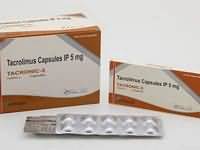
CLINICAL USE
Immunosuppressive agent:Prophylaxis and treatment of acute rejection in liver, heart and kidney transplantationTreatment of moderate to severe atopic eczema
DOSE IN NORMAL RENAL FUNCTION
Oral:Liver transplantation: 100–200 mcg/kg/day in 2 divided dosesKidney transplantation: 150–300 mcg/kg/ day in 2 divided dosesHeart transplantation: 75 mcg/kg/day in 2 divided dosesIV:Liver transplantation: 10–50 mcg/kg as a continuous 24 hour infusion, starting 6 hours post surgeryKidney transplantation: 50–100 mcg/kg as a continuous 24 hour infusion, starting within 24 hours of surgeryHeart transplantation:PHARMACOKINETICS
DOSE IN RENAL IMPAIRMENT
GFR (mL/MIN)
DOSE IN PATIENTS UNDERGOING RENAL REPLACEMENT THERAPIES
IMPORTANT DRUG INTERACTIONS
Potentially hazardous interactions with other drugsIncreased risk of hyperkalaemia with: potassium-sparing-diuretics and potassium salts
ADMINISTRATION
Reconstition
–Route
IV, oral, topicalRate of Administration
Continuous infusion over 24 hoursComments
Dilute in glucose 5% or sodium chloride 0.9% to a concentration of 4–100 micrograms/mL, i.e. 5 mg in 50–1000 mLIncompatible with PVC.
Add to either glucose 5% in polyethylene or glass containers or to sodium chloride 0.9% in polyethylene containersContains polyethoxylated castor oil which has been associated with anaphylaxis
OTHER INFORMATION
When converting from oral to IV, give one fifth of the total daily dose over 24 hours and monitor levelsAlso available as a 0.03% and 0.1% ointment for eczema and anal Crohn’s diseaseApproximate whole blood ranges: Initially: liver: 5–10 ng/mL, renal: —8–15 ng/mL . Maintenance: 5–15 ng/mL —.